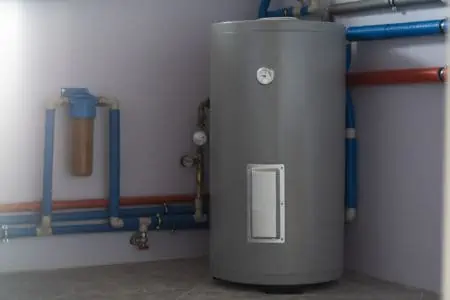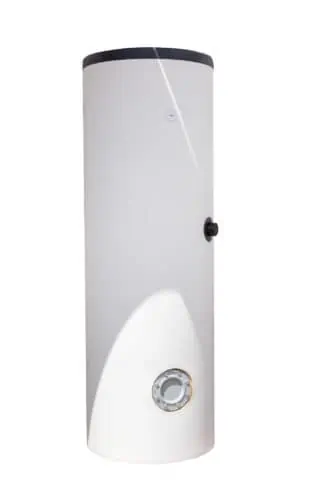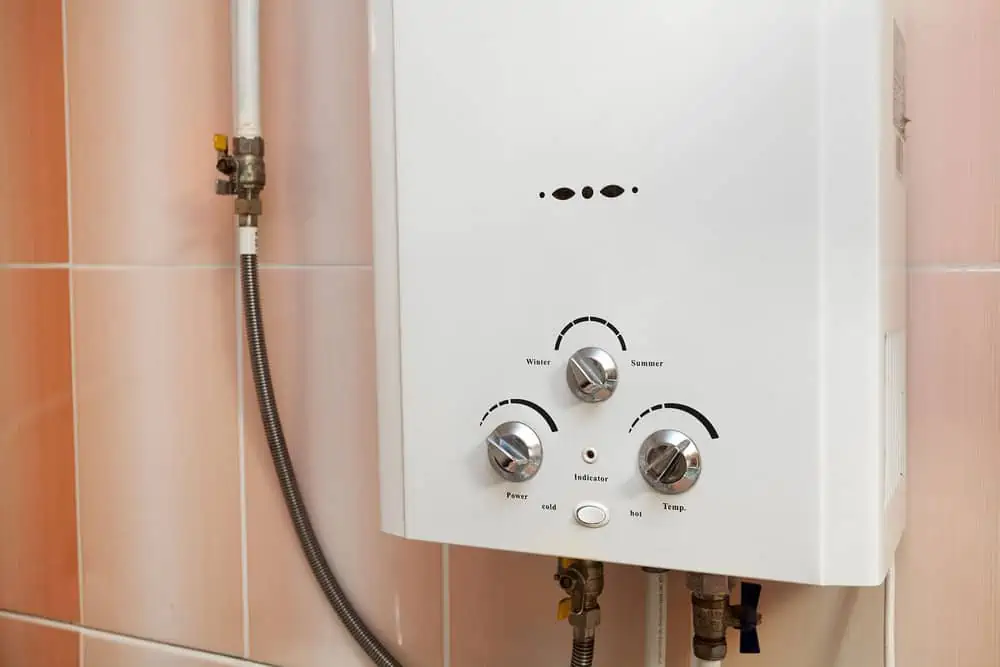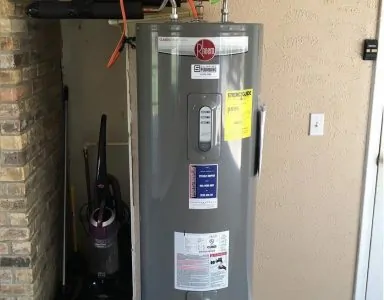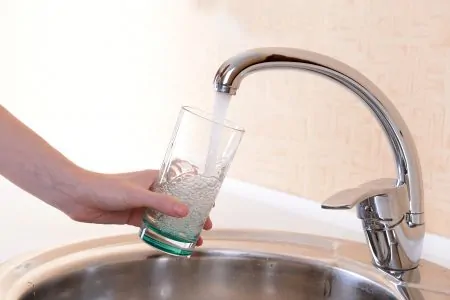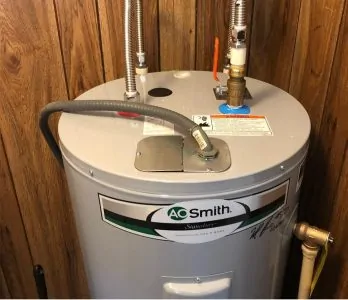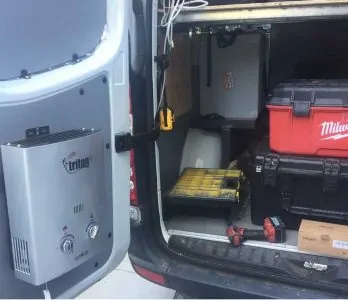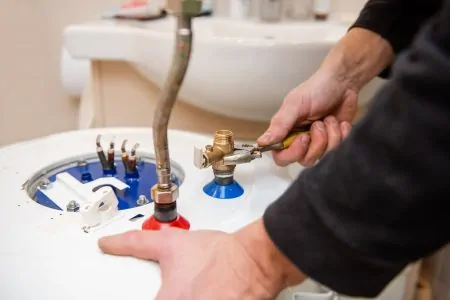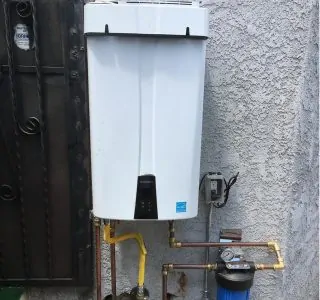Indirect water heaters are not a new invention. They have been around for years. But with the focus firmly on the environment and energy costs soaring, they are enjoying a resurgence in popularity.
We show you the pros and cons of an indirect hot water heater, compare it to a tankless version, and highlight a few models worth your attention.
Key Takeaways
- Indirect water heaters are energy-efficient and use your existing boiler as a heat source, reducing power usage and lowering energy costs.
- These heaters are suitable for homes with a furnace and not for those with an HVAC system.
- Indirect water heaters can be more expensive initially but provide long-term savings on energy bills.
- When choosing an indirect water heater, consider the size suitable for your family and consult a professional if necessary.
What Is an Indirect Water Heater?
Indirect water heaters have no heat source, so they don’t have a heating element or independent gas supply to warm the water.
An indirect-fired water heater uses an external source to heat water. It taps into your home boiler located in the basement and draws on the gas or electricity to provide hot water.
Given that water heaters are among the most energy-hungry appliances, indirect models make sense because they are energy-efficient. You only need one source of gas or electricity, which reduces your power usage.
Also, indirect water heaters are energy-efficient because they store hot water ready for use, which means that your gas furnace doesn’t need to turn on and off frequently, saving you money.
So, how does an indirect water heater work? Looking at the diagram above, it starts with heat transfer from your existing boiler. A series of heating coils sit between the heat source and the storage tank. As water passes through the supply pipe, it gets extremely hot and vaporizes.
When the water hits the water heater tank, it becomes liquid again and is returned back to the boiler in a never-ending cycle. This water is then fed to your home for domestic use.
Are Indirect Water Heaters Worth It?
The Department of Energy believes that indirect water heaters are the most energy-efficient way of providing domestic hot water. Unlike tanked systems, indirect water heaters have a limitless gallons per minute water supply.
They put less strain on your existing furnace, and you burn less gas, propane, oil, electricity, or whatever energy source your boiler uses.
Installing an indirect (combi) system is cost-effective if you build a new home. However, they can be tricky and expensive to retrofit to an existing system.
Average Price of an Indirect Water Heater
It seems like a great point to talk about cost. These combi systems are expensive In the short term, especially if you are retrofitting one. Long-term, they do save you money on energy bills.
Expect to pay between $800 and $1,500 for your new water heater. The higher end of the price range will include installation, but if you choose a separate contractor, add another $500.
Advantages and Disadvantages of Indirect Water Heaters
Your decision to (or not, as the case may be) purchase an indirect water heater depends on the good outweighing the bad. Weighing up the pros and cons provides clarity. Let’s take a look:
Pros
- Better energy efficiency.
- Easier to maintain.
- Reduced flue gas loss (one of the biggest inefficiencies in gas boilers).
- Lower energy costs.
- Greater gallons per minute rate.
Cons
- Expensive to retrofit.
- Not suitable for homes without a furnace.
Indirect Water Heater Vs. Storage Tanks
How do these water heaters compare to traditional water heaters with a tank? Do they make financial sense, and which should you choose?
Indirect Water Heaters
Indirect water heaters have a storage tank, just like tanked heaters, but they don’t have a heating element to warm the water. They deliver better heat efficiency because they connect to your existing boiler as a heat source.
Indirect models require less maintenance, are easier to install, and are ideal for newly built homes. They are typically smaller, but that doesn’t mean you get less water. Because the system recycles the hot water, you get a greater gallons per minute rate.
Indirect water heaters are more expensive in the short-term, but can provide savings over longer periods. You also get improved recovery rates (the time it takes to fill an empty tank and heat). This helps reduce your energy bills.
Storage Tanks
Storage tanks have an independent heat source in the form of heating elements. They either burn gas or use electricity, making them less energy-efficient. If you also have a furnace, you have two significant appliances burning fuel.
A water tank takes longer to heat, and when the tank empties, it has a longer recovery time. Traditional water heaters are also larger, taking up more room. It makes them unsuitable for small apartments.
Storage tanks typically have a 40-gallon capacity, although a 50-gallon tank will meet your water needs better for an average family of four.
Tanked water heaters have to be at least six feet from the floor. This helps with water pressure levels, ensuring a strong water flow. Tanked systems are cheaper in the short term but cost you more in energy bills over the long term.
Here’s a handy guide for an at-a-glance view:
| Indirect Water Heater | Storage Tank | |
| Efficiency | Highly efficient because it has no heat source. | Use gas, electricity, oil, and other dedicated heat sources. |
| Size | Smaller tank size but better gallons per minute rate. | Not suitable for small spaces. Tanks hold 40 or 50 gallons. |
| Price | $800 to $1,500 on average. | $300 to $550. |
| Ease of maintenance | No heating element or thermostat. | Requires yearly maintenance. |
Indirect Water Heaters Vs. Tankless Water Heaters
We’ve compared indirect water heaters to storage tank systems, but how do they compare against tankless models?
Indirect Water Heaters
Because indirect water heaters have no power source to heat the water, they are more efficient. The most apparent difference between tankless and indirect heaters is the existence of a water storage tank.
While it has a better recovery rate than a tanked water heater, it still takes up more room than a tankless model. Indirect heaters also need a secondary heat source, like a furnace.
If your heating comes from an air-source heat pump as part of a HVAC system, you cannot use an indirect water heater. The good news is indirect heaters require less maintenance because they have fewer components that could malfunction.
Tankless Water Heaters
Tankless water heaters are also known as on-demand appliances because you only heat the water you use. Cold water passes through a heat exchanger inside the system and flows out warm.
Tankless models offer better heater efficiency than tanked systems because you have no tank to heat. However, they are less efficient than indirect heaters because they still use energy. Typically, tankless heaters burn gas, propane, or oil.
A tankless heater is impossible to beat when it comes to size. They are the best option for small apartments because they have no storage tank. Tankless heaters need yearly maintenance and should only be serviced by a qualified contractor.
You will notice the difference in price between tankless and indirect water heaters. A tankless model will set you back on average $2,216, making them among the most expensive on the market.
Here’s a handy at-a-glance guide:
| Indirect Water Heater | Tankless Water Heater | |
| Efficiency | Highly efficient because it has no heat source. | Burns gas, propane, or oil to create heat. |
| Size | Smaller tank size but better gallons per minute rate. | The most compact of all water heater types. |
| Price | $800 to $1,500 on average. | $1,170 to $3,330. |
| Ease of maintenance | No heating element or thermostat. | Requires a yearly service by an expert. |
Best Indirect Water Heaters
We’ve spoken at length about the virtues of an indirect water heater, but which brands warrant your attention? Here is our take on the top indirect water heaters to consider.
Triangle Tube Phase III Indirect Water Heater
This is a self-cleaning water heater with a tank capacity of 36 gallons. While that may be on the small side, at least you don’t need to worry about descaling the heat exchanger.
It has a removable top for quick access to the inside of the tank and an exclusive tank-in-tank system that insulates and keeps the water hotter for longer. It also delivers more efficient heat transfer.
The Triangle system has a flow rate of 400 gallons, and it delivers 12.5 gallons of hot water per minute.
Burnham AL35SL Alliance
This model boasts a high-capacity coil that can deliver hot water faster than other similar models. It also has a faster recovery time, so you spend less time waiting for hot water.
The tank is made from Hydrastone to prevent mineral contaminants from adhering to the inside of the tank. This protects the tanks and prevents corrosion. This model also has a thick insulation layer, keeping the water hotter for longer.
Crown MS2-50 Mega Stor
This Crown indirect water heater has a storage capacity of 53 gallons, making it ideal for medium residential households. It has a first-hour rating of 236 gallons and delivers 193 gallons per hour of continuous draw.
It has a heat loss rating of 0.9 degrees Fahrenheit per hour, which is higher than some competitors, indicating the need for improved insulation.
FAQs
Final Thoughts
When choosing an indirect-fired water heater, consider whether it has the capacity you need and if it works with your existing furnace. It might be better to get some professional advice before proceeding.
Indirect water heaters are an excellent alternative to traditional tanked and tankless water heaters and are about 30 percent more efficient. If saving money and helping the planet makes you smile, get an indirect water heater.
